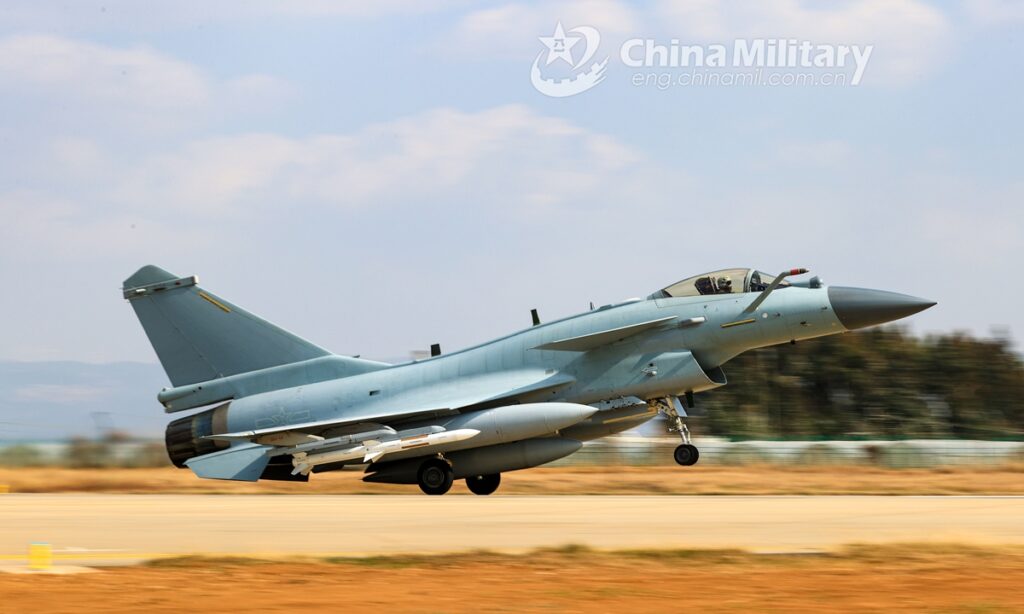After alleged images of the J-10C fighter jet with the marking of the Pakistan Air Force recently emerged on social media and were widely circulated by media outlets, Chinese analysts on Sunday lauded the latest defense cooperation between China and Pakistan, saying that the move yields great significance to both countries, in terms of boosting combat capabilities of the Pakistan military, promoting China’s aviation equipment, and responding to both countries’ security interests in the region.
First published on social media on Tuesday, the images show two J-10Cs, equipped with China’s domestically developed WS-10B Taihang turbofan engines, undertaking test flights at an undisclosed location, UK-based defense news website Janes.com reported on Wednesday.
“If confirmed, this could be the first time China has exported the J-10 series fighter and also the first time it has exported the WS-10 series engine,” observers said.
While the authenticity of the images remains unknown, Pakistan’s Interior Minister, Skeish Rashid Ahmed, told the media in December 2021 that a first batch of J-10Cs will be introduced during the fly-past that will be held for the commemoration of Pakistan’s Republic Day on 23 March, 2022, according to the report.
“The J-10C will significantly enhance the combat capabilities of the Pakistan Air Force,” Chinese analysts said.
“The J-10C is a 4.5-generation medium-size fighter jet and is more powerful than the China-Pakistan jointly developed lightweight fighter jet, the JF-17, which is currently in service with the Pakistan Air Force,” Shi Hong, Executive Chief Editor of the Chinese magazine, Shipborne Weapons, told the Global Times on Sunday.
“The J-10C is larger and can be equipped with a bigger active electronically scanned array (AESA) radar than the one used by the JF-17 Block 3,” Shi said, noting that the J-10C can also carry more advanced, fourth-generation air-to-air missiles including the short-range PL-10 and the beyond-visual-range PL-15.
“The J-10C is also significantly more powerful than the old US-made F-16 fighter jet of the Pakistan Air Force and can rival the Rafale fighter jet that recently entered service with the Indian Air Force,” Shi said.
“Pakistan’s J-10C will not replace the JF-17, but form a combination, leading to higher combat capabilities,” Shi said.
In addition to the J-10C, Pakistan’s other military branches have also recently commissioned advanced Chinese equipment. For example, the navy received the first Type 054A/P frigate, and the army acquired the HQ-9/P air defense missile system, according to media reports.
“This demonstrates that defense cooperation between China and Pakistan is going even wider and deeper, and the large-scale adaptation of Chinese equipment by all Pakistani military services will significantly boost their combat capabilities,” Shi said, noting that a simple system with most Chinese hardware can also be supply chain friendly.
To China, the first successful sale of the J-10 series fighter and the WS-10 series engine will further open the international market and more countries will show serious interests in Chinese aviation equipment, analysts said.
“Pakistan’s procurement of the J-10C is also meaningful for China and Pakistan as a more powerful Pakistan military can better safeguard the shared interests of the two countries in the region,” Shi said.
During the induction ceremony of the first Type 054A/P frigate in January, the President of Pakistan, Dr Arif Alvi, said that the ship will help to safeguard the sea routes of the China-Pakistan Economic Corridor.
A J-10 fighter jet attached to an aviation brigade of the air force under the PLA Southern Theater Command takes off from the runway during a day-into-night flight training exercise on February 2, 2021. Photo:China Military




